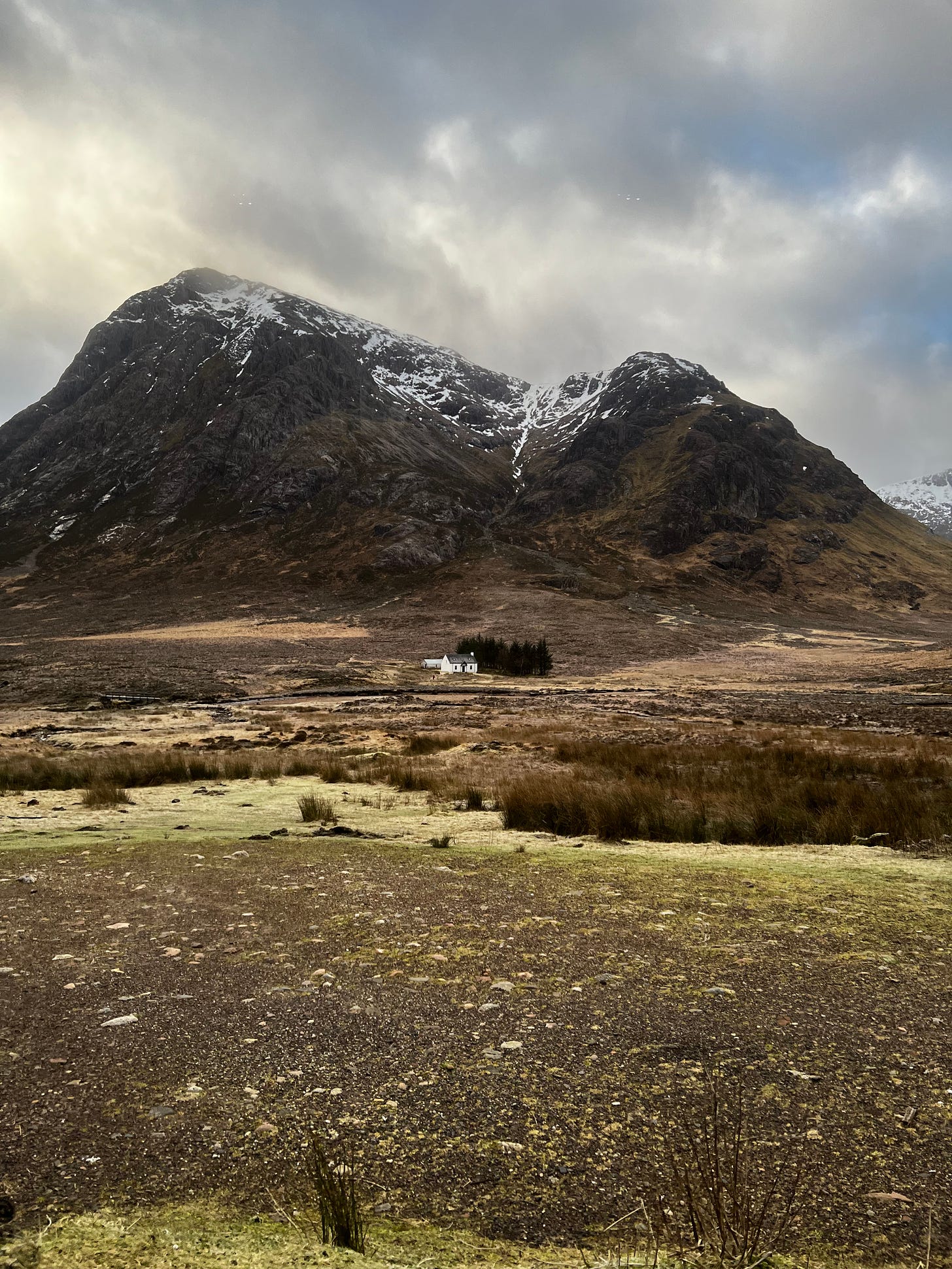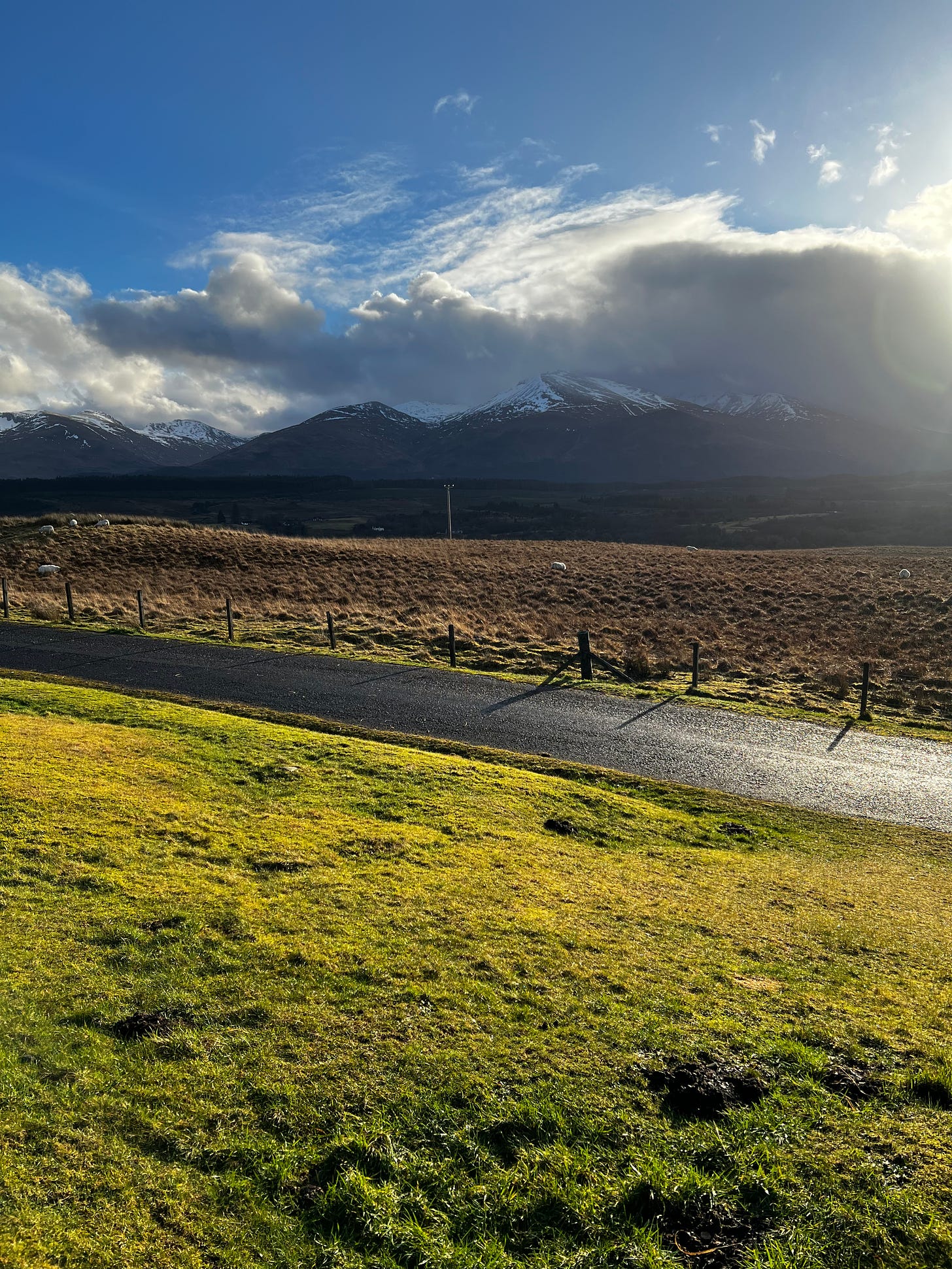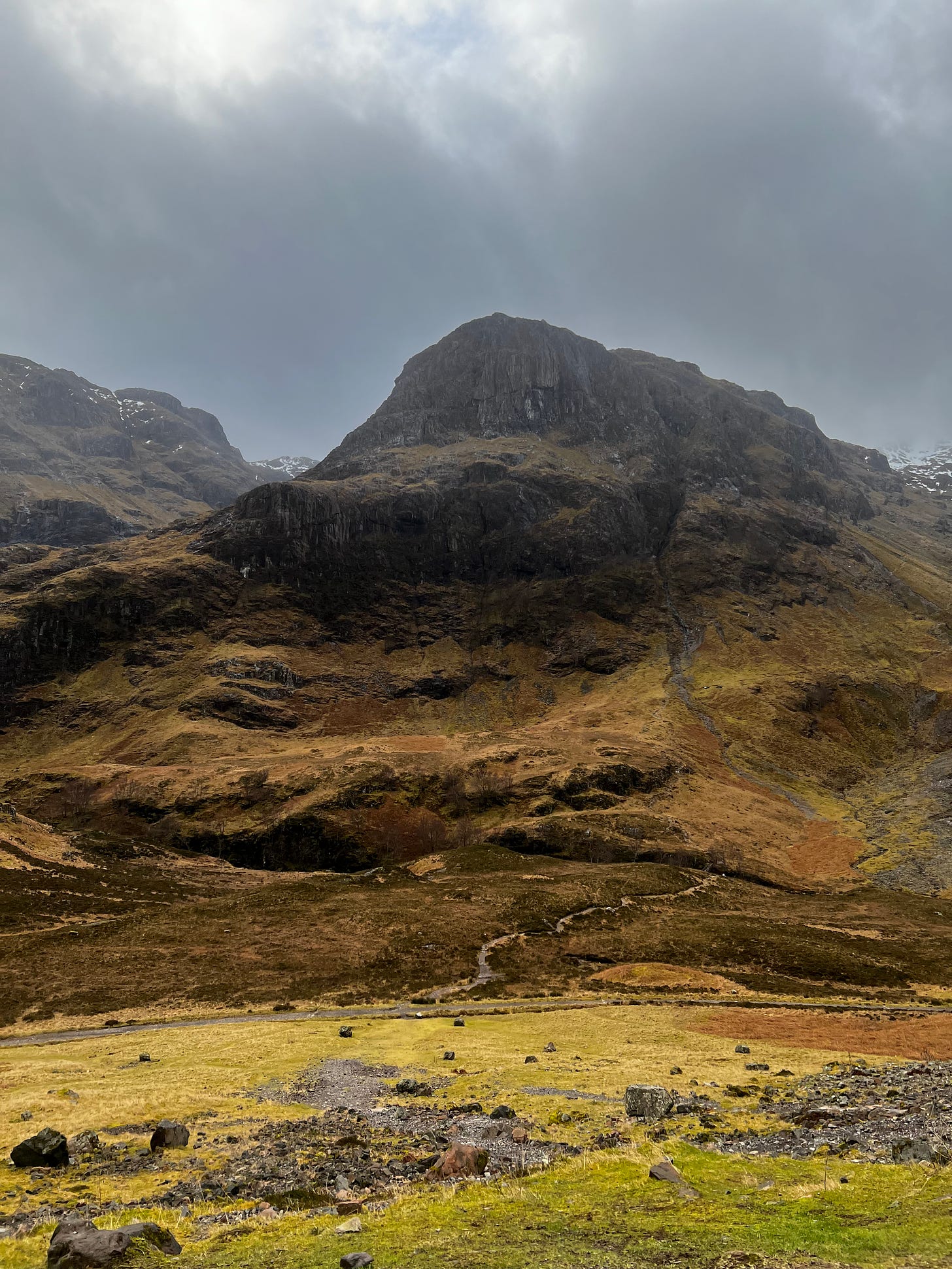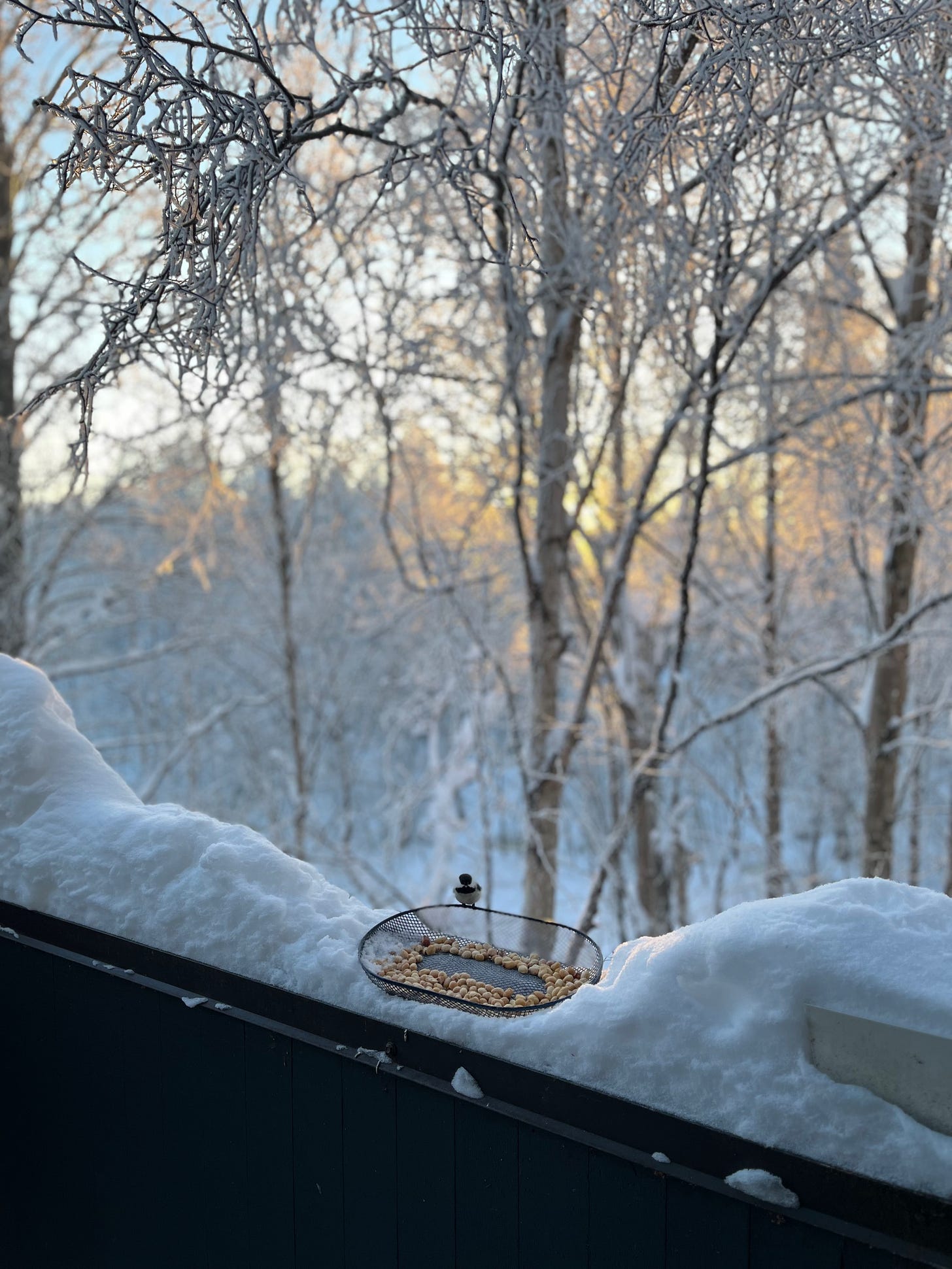Hello friends—
It’s cold today as I write—5F for a high and sinking (oof)—and yet the light is already changing. There is a slight shift in the color of the sky at certain points of the day—it’s hard to describe, but it’s noticeable. The sun is starting to lengthen, ever so slightly, lingering a bit later into twilight.
I’ve lived here long enough now to notice those small, almost imperceptible shifts in the land. Maybe because it’s high latitude, those small changes begin to feel necessary—a way to mark small increments in seasons that either whip past in a flash of color, or seem to never end—or never arrive soon enough.
Transitions—even small ones—are thresholds, lines observed, crossed, mapped. Boundaries to move across and mark the difference. A moment when you recognize the turn of the earth, that while standing still the world has shifted around you, with you, affecting each cell of your blood as it also affects the roots of birches, who feel the light crawl slightly higher on their branches.
Noticing is an offering—of attention to Land, Sun, Moon as she grows fuller in the early night. An act of reciprocity, a moment to remember we too are of this place, this Here. Not as observer, but as a subject among subjects, connected to all that is both visible and invisible—tree and root, the darkness of new Moon, the silvery light of full. Nights of starlight, days of sunlight. All a part of realms that move in and out of visibility.
It had me thinking about how much is missed in a reliance on sight as the only way to see. The etymology of the word invisible is less about what’s absent, but about what is imperceptible to our eyes, what is kept out of sight. The distinction is important—it opens up space to consider how and what around us remains hidden from view. It reminded me of part of a favorite David Wagoner poem, “Lost”:
Stand still. The trees ahead and bushes beside you / Are not lost. Wherever you are is called Here, / and you must treat it as a powerful stranger, / Must ask permission to know it and be known…The forest knows / Where you are. You must let it find you.
It’s that sense of noticing that the forest knows where you are. That we ask permission to know it and be known—to be subject with subject, seamlessly a part of the places we call Here. Stand still—you must let Here find you.
Here is something around you, shifting with you, waiting for you to stay still long enough to be noticed. To be found when we are too often told we must seek.
The day I first wrote the above, I later picked up a history of the witch (as one does) to find a reference, when I was pulled into an entirely different direction:
…there is now a sufficient accumulation of evidence, gathered from periods spanning the medieval, early modern and modern, to enable a confident proposal that Wales, [the Isle of] Man and Gaelic Ireland and Scotland represented a set of societies that traditionally lacked a serious fear of witchcraft… This lack was sufficient to enable them to resist the adoption of large-scale witch-hunting, and in many areas witch-hunting at all, even though for a time that became a characteristic of the English and Scottish states that dominated them.1
Hutton goes on to write in more detail of how these broadly rural ‘Celtic’ lands held beliefs in a variety of spirits tied to the land and animals, water and groves, and that these were collectively treated as powerful forces capable of both good and ill. These were a part of the invisible ‘good people’s realm, who are blessed as they are feared, whose known places and invisible presence invoke respect and deference.
What struck me is how people lived with a landscape of liminal borders, of parallel realms with permeable boundaries. A landscape that was mapped in memory, handed down across generations in story and experience. A land treated as a powerful stranger, with reverence, respect, and an understanding of reciprocity—to not cause harm to the land and the invisible and visible forces who live alongside us.
Hutton writes that in Celtic areas where there are strong traditions of a collective understanding of place, people are less likely to point fingers at neighbors, but understand it as the work of the ‘good neighbors.’ These are traditions that are less about individual power, but the collective power in the landscape, and how to live with it, not extract from it. Memory of story in boundaries and markers that help keep a community safe, while also invoking a sense of subjectivity. These are not traditions where individual property is guarded, so much as the place, collectively, is respected as part of life.
Of course, this isn't specific to Celtic traditions. This is the way that generations of ancestors lived with the lands that supported them, where they lived rooted to both place and memory. Richard Nelson2, e.g., in Make Prayers to the Raven, writes:
…[t]raditional Koyukon people live in a world that watches, in a forest of eyes. A person moving through nature--however wild, remote, even desolate the place may be--is never truly alone. The surroundings are aware, sensate, personified. They feel. They can be offended. And they must, at every moment, be treated with the proper respect.3
I also picked up The Secret Commonwealth of Elves, Fauns, and Fairies by Robert Kirk, a clergyman from the Scottish Highlands who collected his community’s stories and beliefs in the late seventeenth century. Left in manuscript at the time of Kirk’s death in 1692, it was first published in 1815, by the enthusiasm of Sir Walter Scott. It’s one of the earliest studies of folklore, collected in a style similar to documenting the flora and fauna of a location. It documented instead the stories told by the community of place—and at a rather remarkable time for a minister to collect stories of the supernatural, when witches were actively hunted and executed, along with heretics. Marina Warner writes in her introduction to Kirk’s work:
Here was a minister of the Kirk who threw his arms wide to enfold the beliefs of his parishioners, who collected the lore of the people, who was fascinated by their concept of faery. He did not hold with stringent diagnoses of heresy or with rooting it out, but treated popular custom and opinion—and superstition—as worthy of intellectual interest and genuine respect.4
Kirk describes people gifted with second sight and stories of the invisible world that parallels the ‘terrestrial.’ Stories of people who have been enchanted, stolen from, tricked, helped, healed, and protected by ‘the good neighbors.’5 What Kirk describes is a landscape alive with invisible as well as visible forces, lands that hold memory of siths, fairies, spirits, wights, and trows, who lived in rocks, hills, wells.
But it was particularly Kirk’s description of how they inhabited the world that struck me:
Their bodies of congealed air are sometimes carried aloft,…and enter in any cranny or cleft of the earth (where air enters)…the earth being full of cavities and cells and there being no place or creature but is supposed to have other animals (greater or lesser) living in or upon it as inhabitants and no such thing as a pure wilderness in the whole universe.6 p. 7
Wilderness. You cannot visit or live up here and not be confronted regularly by the myth of wilderness. In the legal language of the 1964 Wilderness Act and before, ‘wilderness’ is classified as “an area where the earth and its community of life are untrammeled by man, where man himself is a visitor who does not remain.”
Land untrammeled by man, a visitor who does not remain. Erasing thousands of years of Indigenous generations across the lands of Alaska and their continued presence in these lands, the homelands of their ancestors. What a line to encapsulate the legacy of a white man against the backdrop of landscape, who only visits and is never rooted to place, never deigns to remain, to know something intimately of the land as subject. Instead, we enshrine the objective observer surveying place as something empty, to be used, or ‘improved,’ to extract as resource. Not respect as kin.
I’d argue that the world of the invisible—wind, gravity, storms, and heat—has been speaking back to us, provoking with fire, flood, and heat because of our inability to pay attention, because the western capitalist industrial technological apparatus is far too satisfied with a presumptive control of a solely material world. And still, we wonder if we really notice anything weird.
A collective belief in honoring the land and all it may hold—visible and invisible—would look like No such thing as a pure wilderness in the whole universe. It would be more an acceptance of surrender, an awareness of weirdness, rather than wilderness. Elvia Wilk, in her book Death by Landscape, writes:
Weirdness resists the idea that everything can be explained by humans, but doesn't give up on the importance of human experience and ability to access and affect the world. This requires some kind of surrender to the unknown, which makes humanity itself an unknown category—whose outlines get messy and whose central importance in the universe is not self-evident.7
In the etymology of the word weird, there is an earlier meaning—wyrd. Its definition is hard to pin down—in a reductive sense, it’s tied to fate, like the Norns of Scandinavian myth, the wyrd/weird sisters of Macbeth. But wyrd is more a state of becoming, rather than the idea of a fate that is inescapable—more a sense of the world and time as a web of interconnectedness, that responds to your actions and can work to your advantage, if recognized as such. It’s a word often described with an infinitive verb—the process of becoming; a state of coming to know.
Wyrd as the act of becoming—as if something that was assumed to be inert suddenly moved. Wyrd is not something observed, but something that is interacted with in reciprocity, as subjects of the same world. Less an acceptance of fate, but that it acts upon and with us.
In Wilk’s essays, she writes about many wyrd stories, where women become plants, where the landscape takes over, where what is becoming provokes us into noticing. As she writes, she’s conscious that she’s not writing as an observer, but as a subject experiencing the writing of the book:
what begins as a look outward becomes an interrogation of the writing process and the self. This is a book about becoming what you study, about what it feels like to embed in the landscape.8
Living here almost longer than any other place I’ve lived, I do feel like I’ve learned something of this land, of what it means when snow looks a certain way, the birds that arrive at different times, the rhythms of sap and the brief months of leaf. But I am severed from a community that lived in place for generations, where collectively there was a knowledge and awareness of what was invisible as well as visible. Where there could be a collective memory and understanding of Here.
The intimacy with the world is what I feel most keenly when I read about traditions in deep relationship with place, of how much we have been conditioned to not think of place in terms of subjectivity, of being tied to it, of that being something to honor. To become perhaps not only what you study, but to become where you are.
Which is another reason Kirk’s writing of folklore and his own story is so, well, wyrd. He became a part of what he studied.
It was a common belief in Kirk’s community that those who knew something of the good neighbors would be taken to their realms at the end of their life. It was also thought to be unwise to reveal knowledge of the fairy folk, as it can be disrespectful and invite punishment. Both of these aspects of fairy lore became a part of Robert Kirk’s story in his death:
On the evening he died, Kirk had taken a stroll on Doon Hill behind his manse. He collapsed and was subsequently buried in the Kirkton graveyard, Aberfoyle. Sometime later, the deceased was seen by a relative to whom he gave a message, to be passed on to his cousin, Graham of Duchray. Kirk explained that he was not dead, but was held hostage in Fairyland. He said he would appear again, at the baptism of his posthumous child, only this time Graham was to throw a dagger above the apparition of himself, thus releasing him from the fairies. When the day arrived, Kirk did indeed appear, but his cousin was so startled that he forgot to throw the dagger. The spectre vanished and it is firmly believed…that he is, at this day, in Fairyland.9
Two centuries after Kirk’s death, there are still people who remember this story of Kirk’s death.
The landscape finds us—the visible and invisible—and shows us what is Here. That we are subject, can become a part of what we notice, attend to. That we are in reciprocity with Here. While Kirk’s life—or death—became lore, the land now also maps in memory where he may have strayed too far in making visible what should remain invisible. He too became a part of the landscape. Part of traditions that believe what is invisible is powerful, a reminder that perhaps the shape of our lives is more wyrd than we know. That sometimes we need to let Here find us, instead of always moving, seeking. Visiting.
And so: I look for the wyrd and try to recognize its bending of time and space, to see by feeling as much as by sight. To remain subject and resist the objective gaze that would have us survey everything as separate from ourselves—to remember that there is no such thing as a pure wilderness in the whole universe.
Hutton, Ronald. 2017. The Witch: A History of Fear, from Ancient Times to the Present. Yale University Press. p. 260-1
This is a book from the 80s, and it is problematic in that it is a white male writer sharing stories of the Koyukon people—there is something interestingly similar to Kirk writing about the traditions of people he also lived with (and the end of his story speaks to the fact that perhaps he should not have been so bold). And yet both men wrote out of respect and interest in what the community they lived in could tell them about place, and community. And there are problematic legacies of the observer in this, and also moments of beauty and wisdom of place… so how to hold both or all aspects of these stories…
Nelson, Richard K. 1986. Make Prayers to the Raven. University of Chicago Press. p. 14
Kirk, Robert. 2019. The Secret Commonwealth: Of Elves, Fauns, and Fairies. New York Review of Books. pp. ix-x.
“The word fai or fay itself originally functioned more often as a verb than a noun, to denote the making of something magical and strange, in both Old French and the English texts into which the French themes were transposed. Its derivation or parallel development 'faierie' was evolved to refer to uncanny events and phenomena, rather than creatures, and only began to refer to a type of being in English in the fifteenth century. “(Hutton, pp. 229-30). The Old English term for these beings was elves—which survives today in Iceland, known as the ‘hidden people.’
Kirk, Robert. 2019. The Secret Commonwealth: Of Elves, Fauns, and Fairies. New York Review of Books. p. 7
Wilk, Elvia. 2022. Death By Landscape. Soft Skull Press. p. 22
Ibid. p. 23
Henderson, Lizanne and Edward J. Cowan. 2001. Scottish Fairy Belief. Tuckwell Press. p. 172-3

















“Noticing is an offering—of attention to Land, Sun, Moon as she grows fuller in the early night.”
As one does…. ❤️
This piece has given me so much to think about—it will stay with me for a long time. I paused in the middle to order the book on witches and the others you cited are in my list as well.
I really want to bring it into dialog with the (christian white-supremist) homesteader lore that shaped my upbringing. I grew up in Homer, Alaska, and my immediate community was a small country church on a dirt road 20 miles east of Homer. It was a church that organically grew out of a bible study in the 80’s and was pastored by the son of a homesteader. One thing that has been difficult to reconcile in my own psyche is the strong sense of place and local culture, so rare in modern America, that I grew up with, combined with a lore that divorced me from the place and from my own psyche.
I am thinking, particularly, about bears. I grew up in terror of bears. At potlucks third-hand stories of bear attacks would loom large. Women, in particular, fell victim, because they were on their periods, or because she awoke first, and when she lifted her hand to wake her husband she was pulled out of the tent by her feet. Only men ventured into the wilderness. Only with powerful guns and four wheelers and canvas wall tents. I was TERRIFIED of the forest. I remember venturing on a brief hike with a friend when I was 15, my body tense with fear. At one point she let out a little yelp because she tripped on a root, and with a blood curdling scream I took off running.
In my twenties the terrifying lore was slowly replaced with best practices that make hiking safe enough, the realisation that, statistically, my hike was less dangerous than my drive to the trailhead. I slowly became a woman connected to, shaped by the forest. I lived in Anchorage during this time, but would occasionally return to Homer, and it began to puzzle me. These men, who had lived at the edge of Alaskan forest since the 1950’s, who planted and harvested, knew its seasons and soil so much better than I, spoke with so much terror, required so much armour; when I would wander into the Chugach mountains with nothing but a bottle of bear spray and my own two legs. It was the lore.
A couple years after I moved from Alaska a teenage boy was killed by a bear while running one of Alaska’s most popular (and populated) mountain races (Bird Ridge). The lore invaded one of my safest (due to popularity) and most frequent hikes, and I wondered if the Alaskan forest was shut to me after all, if it was indeed only a region for men and their guns.
Forest lore functions differently in my history than in this piece. I just think it’s interesting how it takes shape to divorce us from ourselves and our world when connection to place is married to Christian white-supremist patriarchy, as it is among homesteaders in the west.
As a side note (or maybe burying the lede?) during my teen years my church turned toward the charismatic; and bears, when they turned up in dreams or stories or on your land, represented the demonic. They became literal representations of the shadowy regions of the psyche, to be feared and exorcised. There was no room, in our collective story telling and psyche, for the autonomous and dignified existence of a creature that reminds us of our vulnerability, of the shadowy side of reciprocity (we nourish and are nourish, know and are known, kill and are killed).